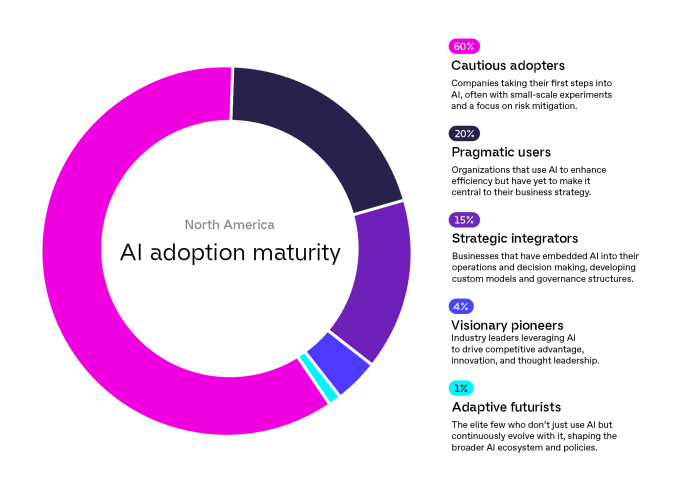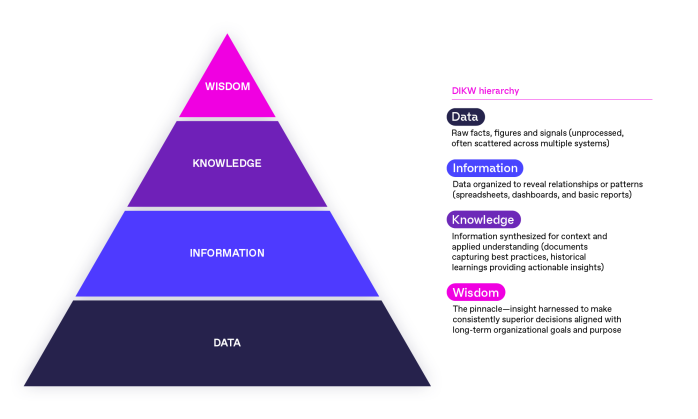In short, most companies are not AI-ready yet. Only a small fraction have built the strategic foundations required to advance along the AI journey—from exploration to scalable execution—while the rest are still catching up.
The difference between AI adoption and AI readiness is critical. Adoption might mean deploying an AI chatbot for customer service. Readiness means having the data infrastructure, organizational capabilities, strategic alignment, and governance frameworks necessary to scale AI strategies and derive meaningful, sustained value.
Core dimensions of AI readiness for mid-market leaders
Through our assessment, we identified three critical dimensions that separate AI-ready organizations from those still building their foundation.
Organizational readiness gaps (80% need support)
The human dimension represents the most critical aspect of AI readiness. Only 20% of companies are "highly prepared" on the talent front, creating a severe shortage of AI-literate professionals. Mid-market companies compete with larger enterprises offering more compelling compensation packages and career trajectories.
Culture of experimentation becomes essential. Organizations that embrace calculated risks, value data-driven decision making, and maintain openness to innovation create environments where AI initiatives flourish. This cultural transformation demands an organizational mindset that sees technology as an enabler of human potential rather than replacement.
Change management capabilities prove crucial as AI implementation reshapes workflows, alters job roles, and impacts established organizational dynamics. Success depends on transparent communication, employee engagement, and proactive efforts to address legitimate concerns.
Data foundations lag (71% not AI-ready)
The foundation of any AI initiative lies in data quality and accessibility. The challenge is substantial: 71% of foundational organizations have outdated data systems that cannot support modern AI deployment. This technical fragmentation encompasses years of accumulated business processes resulting in data silos and inconsistent management practices.
Data accessibility becomes paramount when AI systems need insights from multiple sources simultaneously. Organizations excel when they seamlessly integrate information from ERP platforms, sensor networks, customer touchpoints, and operational systems. Real-time data pipelines enable responsive, adaptive AI applications that deliver immediate business value.
Importantly, your data doesn’t have to be fully ready all at once. What matters most is that the data needed for your priority AI use case is accessible. In many cases, this happens through phased improvements that allow for quick wins while building toward more comprehensive data foundations.
Vision & leadership misalignment (65% lacking clarity)
Strategic alignment ensures AI initiatives serve broader business objectives rather than existing as isolated technology experiments. Less than 35% of firms have a clear generative AI vision, creating fundamental disconnect between AI investments and business strategy.
Leadership alignment proves critical—around half of AI laggards have leadership alignment, compared to 72-83% of AI leaders. This goes beyond budget approval to include genuine understanding of AI's transformative potential and commitment to necessary organizational changes.
Five key barriers mid-market companies face
Our assessment identified five interconnected challenges that consistently impede AI readiness.
1. Talent shortage
The competition for AI-skilled talent intensifies as enterprises and mid-market companies pursue similar capabilities. Even large organizations struggle—61% of leaders note that emerging technologies like AI make recruiting top tech talent harder. Upskilling existing employees offers a practical solution through targeted training in AI fundamentals, data literacy, and no-code AI tools.
2. Legacy infrastructure & data silos
Fragmented systems create barriers to comprehensive data access that AI systems require. The solution often involves hybrid approaches using cloud-based AI capabilities to complement existing infrastructure rather than replacing it entirely. Data consolidation and governance frameworks help standardize fragmented data sources.
3. Unclear ROI
Only 48% of mid-market organizations use KPIs to measure AI performance. This creates a circular problem: substantial implementation resources are difficult to justify without clear payoffs, but AI benefits often manifest indirectly across multiple organizational functions.
4. Cultural resistance
Resistance reflects legitimate concerns about workflow disruption and job role alterations. Half of tech leaders expect to both lay off and hire workers to accommodate AI adoption, creating understandable employee anxiety. Addressing this requires transparent communication about AI's augmentative rather than replacement role.
5. Budget constraints
Mid-market organizations must balance innovation investments against operational necessities. While AI leaders invest 6% of annual revenue implementing AI, analytics, and data, mid-market companies often operate with limited discretionary resources.
Mid-market leaders: What sets them apart
Our research identified distinct characteristics separating "AI Contenders" from "AI Achievers."
AI Contenders make progress through small wins and focused strategies, approaching implementation cautiously with single-use cases or departmental experiments. While this minimizes risk, it can limit transformative potential.
AI Achievers align AI projects with long-term vision, governance structures, and sustained investments. They demonstrate several hallmarks of high readiness:
Cross-functional alignment ensures AI initiatives receive support across departments and organizational levels. Rather than siloing AI within IT teams, these organizations create governance structures including diverse stakeholders from business units, operations, and leadership.
Phased pilots with measurable ROI provide proof points that build organizational confidence while minimizing risk. These focus on high-impact, low-complexity applications demonstrating value within three to six months.
Proactive use of low-code platforms democratizes AI development, enabling business users to create AI-driven solutions without extensive technical expertise. This approach helps address talent shortages while accelerating time-to-value.
Emerging areas of opportunity
Three AI applications hold exceptional promise for mid-market companies.
Retrieval-augmented generation (RAG)
RAG combines retrieval-based systems with generative AI models to deliver context-aware, dynamic responses. For organizations with distributed knowledge bases, RAG can surface valuable insights without the cost and complexity of training custom models. A manufacturing firm can deploy RAG-enabled systems providing real-time, contextual responses to employee questions while citing specific source materials.
Agentic AI
Agentic AI involves autonomous software agents capable of proactive decision-making. In distribution centers, AI agents might autonomously re-route shipments when detecting delays or inventory shortages, weighing routing options and executing optimal solutions. While possibilities are significant, ethical and accountability concerns require careful consideration.
Moving from data to wisdom
The DIKW hierarchy provides a framework for understanding how AI transforms raw data into actionable insights. Mid-market firms often stall at the "information" level, building reports and dashboards without converting insights into knowledge or wisdom at scale. AI techniques excel at moving organizations beyond raw data by spotting complex patterns and forecasting trends.



